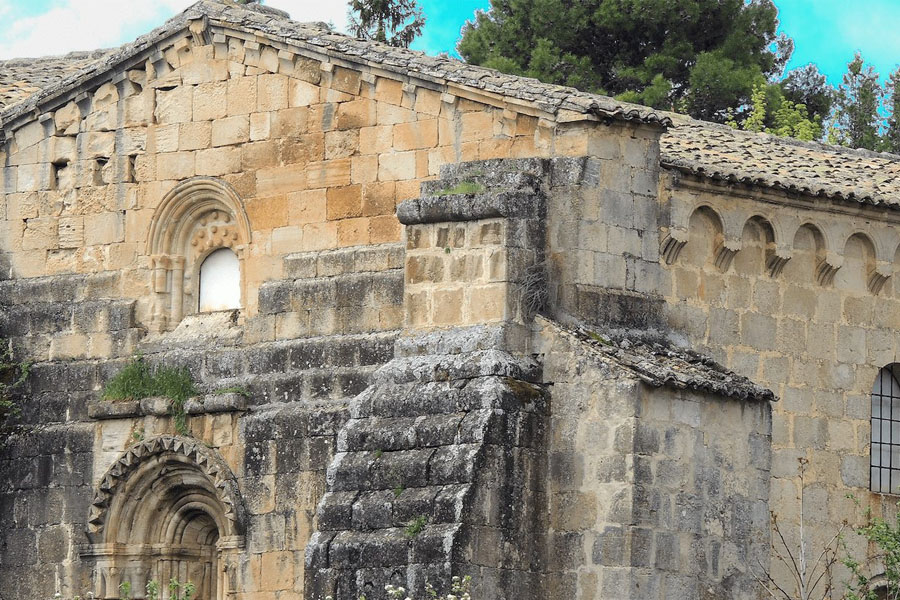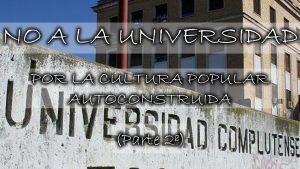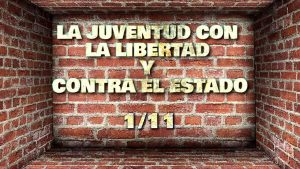Our Architecture is Not Just Physical: On Félix Rodrigo Mora’s History of Romanesque Architecture

Félix Rodrigo Mora represents a muted voice in the Spanish public sphere. A controversial thinker, he was somewhat involved in the early days of the 2011 protests that eventually led to the creation of Podemos (a party he opposes). Apart from certain positions which render him ideologically anathema to the establishment left, his low profile might partly be owed to certain contradictory or unevenly developed positions, some of which will be explored here. He is best described as a defender of those medieval arrangements that constituted a system of village-level direct democracy, mainly concerned with administering ‘el comunal,’ the commons, and which partly survive into the modern era.
In line with this project, his history of (mainly eleventh and twelfth century) rural Iberian Romanesque architecture attempts to deduce the social and ethical implications of its object of study. Mora considers this architectural style to somehow encode what he considers natural (village-level) human conviviality. He provides an excellent analysis of overlooked symbolism and institutions, but ends up constructing artificial oppositions (between the local and the universal, rustic art and geometric pattern, community and monarchy, etc.). I aim to discuss the work in terms of its aesthetic theory, and will leave the historical account it articulates more or less unremarked, except insofar as this touches on the aesthetic dimension.
We might summarize the thrust of his approach by noting that Mora rejects aesthetic grandeur, considering it a violence against the supple, the frail, the ordinary. A principled refraining from artistic idealization and symmetry apparently works to dignify the quaint and quotidian. This is the thesis, and it is at least as much political as aesthetic. It proceeds in terms of what the author takes to be the genuine spirit of Christian sociability (for which he provides a comprehensive account in terms of equal sharing of obligatory manual labour, mutual aid, communal property, local assemblies, rural living and the Spanish foral regime, equivalent to English common law), as opposed to ‘the state.’ It is not simply that Christianity is best pursued outside the state. Christianity is treated as necessarily opposed by the state, and not just by the modern, liberal state, but medieval monarchies too.
In terms of how the argument is made, it inherits a common mis-reading of Plato according to which the Athenian held his archetypes to be detached from the sensible world, rather than being the latter’s depth-dimension, like a pool beneath its vapours, iron within its rusty surface—a mental abstraction rather than beyond the mind. Platonism, then, leads to aesthetic abstraction being valued over natural forms, the state having priority over the commons, and so on.
Mora sees Spanish Gothic or ‘Ojival’ stonework as Platonic, arguing that it sunders its admirer from the actually-existing world, being too geometric, or else too grand and clean, too perfect in its human representations. One may happen to react in this way when contemplating Gothic cathedrals, as not all persons benefit equally from a particular diet in food or literature, and spiritual metabolisms vary. But depictions of geometric patterns, saints, and medieval Castilian gothic psychedelia in stone do not necessarily lead one into the mind and away from the body. They may lead into the spirit.
It is a mistake to assume that concrete rural scenes like those in the small Romanesque parishes Mr. Mora rightly celebrates, lead to appreciating life whereas, contrastingly, Gothic abstraction leads to a sort of world-weary sickness. This judgement assumes only two realities, body and mind, and pits these against each other as starkly as the worldview being criticized: namely the view that there is the body (the world as it is), and there is the mind (sole originator of any form not immediately found out there in the world). This not only thwarts human creativity but also renders the world out there strikingly narrow, as it must consist only of day-to-day communal life and its quotidian charms. On this view, artistic depiction is limited to rearranging empirically available objects and already-observable actions. Such ought to constitute the sole content of art, at least so far as sacred settings are concerned, since the author is mainly discussing churches (though he holds that the real use of these edifices was as much concerned with hosting local politics as the blessed Sacrament, but this only reinforces his essentially aesthetic grounds for opposing the use of artistic abstraction and idealization in those larger Gothic structures whose function was likely more circumscribed to religious observance).
The book attempts to balance body with mind without recourse to spirit. It does not properly account for the spiritual faculty and its bathing of the world with new visions, shepherding what might be out from what is, disciplining and focusing the wandering mind into an instrument fit for poetic purposes. Beauty does not oppose grandeur, but the two are of a piece, one the congealment of the other’s balm. The lofty, abstract and symmetrical qualities of larger cathedrals are not only meaningful to ‘the mind,’ but to the heart, and the same is true of cruder Romanesque sculpture with respect to ‘the body.’
The book’s thesis overlooks this in favor of a tender concern for the organic flourishing of cultural forms, a concern so genuine, so endowed of agapeic verve, as to refuse to rest in the natural partisanship that usually leads an admirer of this or that artistic current to excuse its historical shortcomings. Such excusing of historical shortcomings, however, is barely fathomed by Mora. Even Romanesque architecture, despite mostly appearing as an anti-Gothic champion, occasionally falls afoul of its defender, who notes that this style’s ascent between the 11th and 13th centuries consciously militated against the architecture of Spain’s Repopulation era (between the 8th and 10th centuries).
In relating these—sometimes disastrous—historical turns, a certain prospect begins to loom: the idea that the common folk, the assembly members, those rural, medieval communitarians, might have included among their ranks a not insignificant number of monarchists, lovers of hierarchy, personality-cultists and human-form-idealizers; in a word, that the aesthetic sensibility of common folks may not have been that of the author. Much of what Mora treats as the fruit of repression may instead constitute evidence that what he assumes is the spontaneous shape that human artistic productions when people participate in the governance of their township, isn’t.
Moral seriousness mingles, therefore, with a hypertrophic regard for the vegetable aspects of community. In Mora, the necessary, picturesque, ‘natural,’ portion of life is made to stand in contrast to whatever appears to exceed it. This seems to deny that human flourishing might at times proceed in terms of projects associated with these powers. Yet the pasture need not quarrel with grandeur. In this context, it is immensely difficult to agree with the author that the early 11th century Navarrean king Sancho III’s introduction of foreign monasticism, namely the Benedictine rule, into his realm, was destructive. However much it might have displaced local practices, it was also, in its way, constructive. The fact that Benedict is Europe’s patron saint adds poetry to the affair. We have in the king of Spanish kings, the Rex Hispanorum Regum (as Sancho was referred to during his lifetime), a European vocation. If townships have a right to their unencumbered life, perhaps wider enterprises have their own prerogatives as well.
The book’s distaste for Gothicism rests partly on the fact that, in practice, these structures required a certain social arrangement, being funded by kings or lords. Cathedrals, stone rockets to the noetic heavens, were the fruit of socially hierarchical (though, by modern standards, barely centralized) monarchy. From the point of view of an admirer, however, this might give pause to admiration as easily as work to justify those arrangements, especially given that they were not reliant on some self-evident moral transgression.
In fact, the book’s approach is not medieval, relying on a modern dialectic. It sees larger units embodied in the person of a king as being in opposition to the spontaneous, organic local community. But human beings are always already symbolic in their thinking, and therefore representative and represented. As theologian John Milbank reflected during an interview with me:
Right from the outset of modern thinking about politics in the 17th century onwards, there’s been a tension between notions of representation in the modern sense … on the one hand, and notions of populist direct democracy on the other hand, particularly the idea that states should be founded on a popular vote or else that representatives should be mandated.
Communities are always more than just people gainfully interacting, there is always a political dimension to them just as there is always symbolism in the way we perceive things like eating or relationships.
As for evidence, the author freely grants that there is little to go by, given the substantial erosion of interior mural paintings and external sculptural features in Romanesque structures. This is attributed in part to censorship campaigns carried out by various historical agents, from Cistercian partisans and proto-Gothic art enthusiasts to Franco’s dictatorship. It is suggested that restoration works were used as cover when effacing not only, nor even principally, the erotic content of these churches but also the more politically dangerous communitarian-connoted scenes.
Mora reads carvings on Romanesque relief as hieroglyphs communicating a social program (elsewhere he maintains an anti-programmatic approach to social organization, one that refuses ideology as such, but that nonetheless remains committed to opposing institutions, authority and economies of scale). Further, these hieroglyphs must be read against the grain. The prevalence of lone figures in the artistic renderings of Spain’s Romanesque—figures acting as repositories for an imagined cult of the individual—is discussed as resulting from an institutionally-imposed monarchical mindset, corresponding with the scarcity of group scenes and crowds. It is when making arguments like these that the book’s methodology is at its loosest, accruing evidence for its thesis in pretty clear disregard of what is actually there.
The notion that the Romanesque style constitutes a genre of anti-monarchical, collectivistic, manifestoes-in-stone is anything but clear. Mr. Mora proves that such a position can certainly be reasonably entertained and done so with erudition and an expertly honed eye (albeit such honing projects as well perceives), but it cannot, to date, be treated as the most straightforward reading of these structures and the social arrangements they roofed. We can admire the small assembly, common law, obligatory and equally shared manual labour, neighbourly solidarity, localism, the enclosed-open assembly, as Mora puts it, and the like, without quite experiencing the metastasis of all that admiration into a clear repudiation of any overgrowth or of the state.
It would be possible to describe the human body’s anatomy and functions, its feedback loops, hormonal secretion mechanisms, tremendous complexity and each organ’s capacity for ‘self-management,’ and conclude that a unitary will, the movement of directed desire experienced in a single sentience—the predictive and proscriptive projections in the mind of some bizarre ghost in that magnificent and teeming machine—would be entirely unnecessary and artificial. Yet the human body, for all its internal diversity, does come together, does house a conscious agent that makes and pursues plans, however fumblingly (I do not intend to compare the individual’s conscious agency with the state as we now understand it, but generally to that which exceeds the strictly local). Elsewhere, the author supports local assemblies pooling together into larger ones, but the blanket refusal of a whole aesthetic for being too symmetrical, too vertical, and so, supposedly alienating, implies that his rejection goes well beyond the coercive, centralizing exercise of power.
There is something profoundly right in Mr. Mora’s love of the rural Romanesque in Hispania (for he does not like the word ‘Spain’). It is Spain’s secret protestantism (lowercase ‘p’) and her not-so-secret anarchism. But all this is only one part of the equation—body, to be balanced with mind through spirit; guts and head between which a heart must beat.


